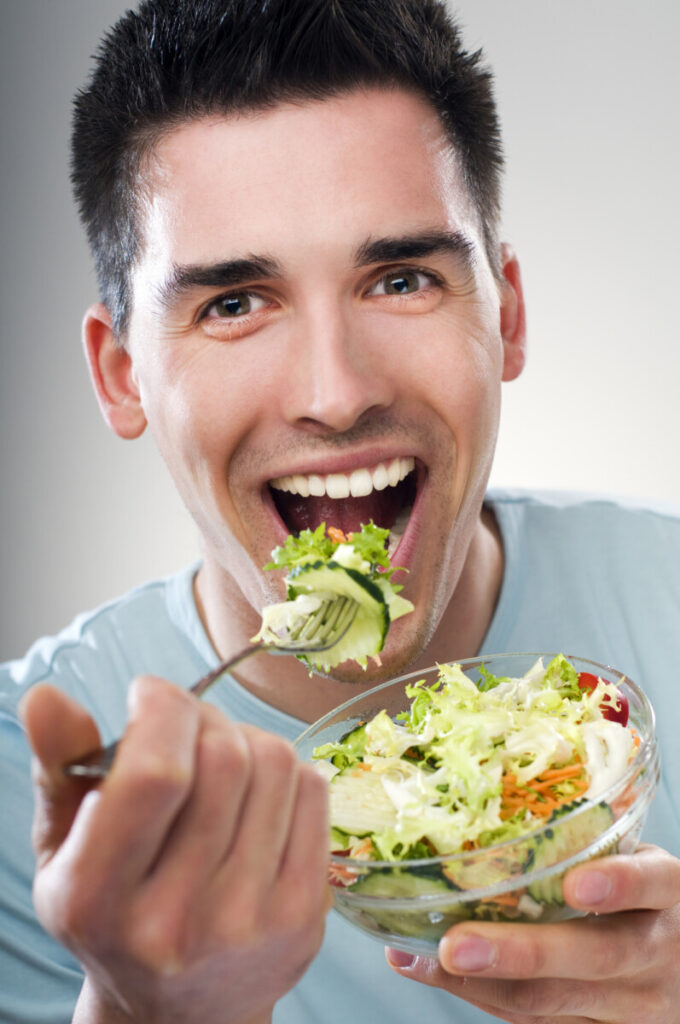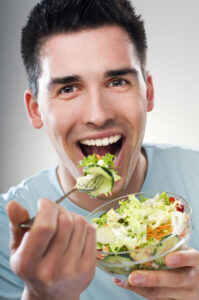
Gay Men and Food: A Dynamic Relationship at Any Age
As of the time of this writing, it’s the holiday season of 2021. And what marks the holiday season more than seasonal foods? Everyone, gay men included, tend to go off their diets and indulge in holiday treats like cookies, candies, baked goods, and winter comfort foods “like Mom used to make” (or still does), and while those goodies might vary by national culture, it’s a worldwide tradition to celebrate in special culinary ways that probably aren’t the most nutritious.
And this got me thinking, as I indulged in various things that under normal, non-holiday-season times I wouldn’t be eating (or at least not as much). I asked myself, “What is my relationship to food?” I work with my gay male clients in therapy and coaching often about this, because food, weight management, and the esthetics of the male physique as symbols of our personal worth and social cache, are frequent presenting issues from my gay male clients, of all ages and ethnicities.
My own relationship with food is “informed” by a demanding, modern, urban gay male culture that tends to put a high value (for better or for worse) on the male physique first, but also a certain “healthier-than-thou” competition of who can “eat clean.” Healthy eating for me is informed by own history of living with HIV for 31 years in 2021, and at various times battling HIV wasting syndrome (involuntary weight loss) due to HIV from the virus itself, or the meds used to treat it. I’ve also had much experience with the lipoatrophy/lipodystrophy syndromes, which, respectively, are the involuntary loss of fat (such as in the face/cheeks, arms, and legs) or the bizarre accumulation of fat (in the belly or behind the neck/shoulders). I remember the days when I was younger at the gym and guys asking me, “Dude! How’d you get those (six-pack) abs??” and while I appreciated the compliment, it wasn’t as much due to my ab workout (although I was fairly diligent with that), it was more about lipoatrophy exposing the abdominal muscles more than what merely crunches or gymnastics would achieve. Like the saying about “The Lord,” HIV giveth and HIV taketh away.
My relationship to food of late has included needing to be low-sodium, high citrate, lower protein, and low oxalate, all due to both a kidney stone in 2021 and chronic kidney damage from the use of “Viread”, an earlier HIV drug. I also have a circulation problem (“venous insufficiency”) in my legs (which is largely inherited), so focusing on foods that either help circulation, or at least don’t exacerbate those problems, has also been important (my article on my personal health crisis just a couple of months ago is here).
During the pandemic, with lots of staying at home, I’ve become more of a “foodie” and cooking more to entertain myself (and “experiment” on my husband, who’s a good sport about what he calls my “making shit up” recipes). Add in my “will” and “will not” eat foods in my vegetarian-with-occasional-exceptions diet, and things get complicated.
Add in, also, my identity/interest/pastime as an amateur bodybuilder (going on 38 years of continuous gym attendance), and feeling like I have to “defend” that against gay community backlash about “Adonis Complex” versus healthy sport hobby, and it gets complicated further still.
 Gay Men and Physique Pressures
Gay Men and Physique Pressures
But as a mental health professional for what will be 30 years in 2022, it’s also incumbent on me to know about, validate, and treat bona-fide eating disorders in anyone, but especially in my focus on gay men. Lots of research indicates that gay men are especially vulnerable to eating disorders like bulimia and/or anorexia, or variations on those, such as the non-official-but-still-an-issue “bigorexia,” or the pathological desire to be muscular, either to attract men, to defend against “looking gaunt” during the height of the AIDS pandemic, or to defend against the homophobic notion of gay men as “not real men.” All of those pressures, and more, are very real, and are cultural detriments to the mental health of gay men in general, and to our relationships with food in particular.
The criticisms of gay men as being superficially and irrationally obsessed with physique have a point. Gay men’s magazines of all kinds, from adult entertainment (porn) to neighborhood “rags” advertising the latest local bar/club events have all tended to feature young, especially muscular, traditionally-beautiful images of young men, as if that type were the only kind of gay man to exist in those local communities. It’s very parallel to the pressures on women to all look like models right out of Vogue or even the (antiquated, sexist) “swimsuit” issue of Sports Illustrated.
But, I’ve written before about how shrill accusations of “body Fascism” and “fat shaming” and such about gay men who have an affinity for the gym, either casually or in formal professional or amateur bodybuilding, are counterproductive. Not all active bodybuilding or fitness participation is “toxic masculinity” or the like. Like most things, it’s a balance. (My previous articles on the gym and mental health connection for gay men are here and here.)
The pressures on gay men about how they look, especially beyond facially and into their physiques, are related to the foods we eat.
The meaning of food for everyone, beyond gay men, is rife with a frustrating complexity. It’s influenced by the mega-money behind the factory farming/dairy/meat/seafood industries. It’s about how corporations that produce food advertise, and the “cheapest foods for the highest profits” thing (such as high-fructose corn syrup and variations on corn). It’s about lobbying (Oprah Winfrey got “in trouble” (aka a lawsuit) when she dared to criticize the American beef industry). Someone recently won a lawsuit for exposing how McDonald’s beef for its so-called hamburgers was toxic.
Food is imbued with cultural meanings. It’s used as a reward for children, especially sugary foods. Food is behind many personal emotional dynamics, such as “reward” versus “deprivation.” Food is verbally labeled with operatically dramatic and judgmental qualities, such as “bad” or “good.” It’s rife with religious connotations, such as “sinfully good” “devil’s food” chocolate or “angel-food” cake. If you eat your vegetables (a culinary “chore”), you get to get your dessert (sugary). If you eat your vegetables, it will “put hair on your chest,” symbolic of high-testosterone boys or men or “manly” (neighbor to toxic masculinity) traits that imply male superiority, next to women or even less “manly” men. Popeye literally transforms into a decidedly-muscular, big-biceped superhero when he eats a can of spinach (what, he can’t find the fresh stuff?), then he can defend the honor of his thin, weak, helpless girlfriend Olive Oyl from the non-consensual advances of his obviously roided-out rival suitor, Bluto. Breakfast cereals loaded with sugar are advertised on children’s Saturday-morning cartoon shows. Expensive, crowded, and “exclusive” restaurants are associated with wealth and status, known for their small portions and high costs. There are even “gay restaurants” to connote who eats there. There are slogans, “real men don’t eat quiche.”
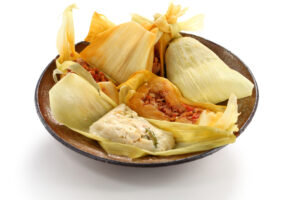
Certain foods mark cultural celebrations or locations. For example, if I say champagne and black-eyed peas, what day is it? In America, those are associated with New Year’s Eve. If I said hard-boiled eggs and jelly beans, when is it? Likely Easter weekend. If I said hot dogs and potato salad, when is it? Probably the Fourth of July. If I said popcorn and Twizzlers (licorice candy), where are we? Probably at the movie theatre. You get the idea. It’s inescapable. So when we (as gay men) have significant mental health issues related to ideas about ingesting food, it’s no wonder; we’ve been “trained” to have “issues” or associations with food our whole lives.
Gay Men’s Rituals and Customs Around Food
Gay male culture specifically has its “food focus.” Bottoms will joke that they “haven’t eaten all day” before a hot date so they can be the receptive partner in anal sex without fear of having to poop anywhere near the time of sex. Gay men at a charity event might look at (ogle?) the sweet foods but avoid them because of “too many carbs.” A gay man’s grocery cart might look very different from his same-age straight peers, with lots of “low-fat” snacks. I would love to know the exact daily diets for the past 30 days of all the guys I see at Pride events or the big dance events where almost every shirtless dancer there has a physique worthy of a fitness magazine, and they’re there by the thousands. If we really tried, we could probably make a list of “gay foods”: protein bars, BCAA mixes, pre-workout mixes, vodka tonics, plain chicken breasts, rice, bananas, and lollipops (and never mind the “banana dipped in chocolate pudding” jokes, OK?).

When gay men grow up with pressures from childhood on with feeling “different” or “less than,” even before they are aware of their sexual orientation (although that comes very young; I was 5 when I had a crush on Kent McCord as the rookie cop on “Adam-12”), they become self-conscious about everything they do: how they talk, how they walk, what they “like,” who they associate with, and what they eat. With regular pressure, we get mild neurosis. Add some more pressure, maybe add in some abuse or other trauma, and we’re in eating disorder territory. Add in pressures to be “manly athletic” and we’re into diet crazes (to gain or lose) or even adolescent (or adult) major steroid abuse (although not all use of anabolics, especially medically-supervised, is automatically pathological; that’s a common myth, even among physicians. Many gay men credit their use of anabolic agents to treat wasting syndrome in HIV/AIDS as the reason they survived to this day).
All of these pressures add up to “food awareness hypervigilance” at every stage of life, but perhaps different pressures or factors at different phases. Let’s look at some of these in turn:
Young Gay Men and the Food/Physique Relationship
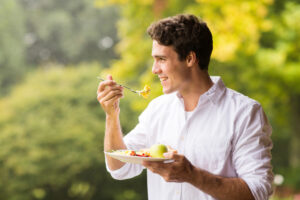
With younger gay men, there are high stakes in the relationship with food. As young adults, gay men are navigating (like their straight counterparts) how to eat now that they’re usually on their own and learning to cook (or at least order out) without the influence of Mom or Dad’s (usually Mom’s) cooking. They have to navigate which of their Family of Origin eating choices they want to keep, and which they want to do away with in favor of their own adult eating choices. There’s what they want to eat, and often what they “can” eat, depending on how good a cook they are. Cooking is usually a skill that progresses as you age, through a lot of trial and error.
Young gay men, often hanging out in groups of gay male peers at bars, clubs, and other gay group activities, usually feel under the most pressure to have the “perfect” physique, because hanging out in groups often means “being compared” within groups. If you want to be able to cook sticking to a perfect Keto diet, but all you know how to do is order fast food on Uber Eats, that’s a problem. Young gay men and their relationships with peers, navigating the (fraught) gay dating scene, often involves feeling pressure to “eat right” to “look right” to “date right”. All of that sounds like more social pressure than it needs to be, but most young gay men feel these pressures and have to develop some kind of response to them – to capitulate, negotiate, or ignore them.
Middle-Aged Gay Men and the Food/Physique Relationship
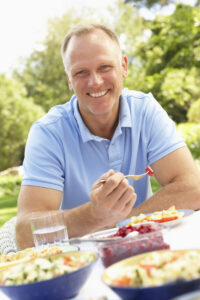
Middle-aged gay men often notice a changing relationship to food, because it’s at this age for most people (of any gender or any sexual orientation) that the natural metabolism slows, making us all realize that we can’t usually eat the way we always used to, because eating the same amounts or types of food will make us gain weight in ways that we just didn’t in the past, when we were younger.
Middle-aged gay men also have the dilemma of whether to try to “battle the bulge” or even to try to defy “middle-aged spread”, or give in to it, and find a new middle-aged peace of mind of accepting that youth is fleeting and not to try to even bother hanging on to the youth that is slipping through our fingers with the seeming passing of every day.
But middle-aged food choices, eating habits, and exercise habits often “cast the die” for how we’re going to be when we’re older – surprisingly “healthy and fit”, even “for our age”, or the beginning of the end for middle-age weight gain, loss of physique shape or cardiovascular fitness, and the health problems that come with getting even older. Overall, it just feels like more of a battle to “look good” than it ever did before.
The cultural issues come into play here, too, because we hear about cultural phenomena like the “dad bod”, with a debate (depending on whom we ask) of whether that’s “hot”.
Fortunately, at middle age, many (not all) gay men have grown in their careers and their overall earning power, helping us to afford to eat “better” (healthier) food, or hire personal fitness trainers. Middle-aged gay men have to answer for themselves the question, “What are my values and priorities when it comes to food, physique, and personal values?”
Senior Gay Men and the Food/Physique Relationship
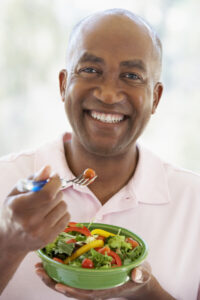 Senior gay men are often in positions of either suffering from the effects of not-so-healthy habits built over many years, or defying the effects of aging and hearing back-handed compliments of how we “look good…for our age.”
Senior gay men are often in positions of either suffering from the effects of not-so-healthy habits built over many years, or defying the effects of aging and hearing back-handed compliments of how we “look good…for our age.”
The individual health status of men comes into play here. It seems that young men are invincible: easy weight management, dark/full heads of hair, athletic prowess, no aches/pains, flexibility/mobility, fast metabolism, relatively easy musculature, no cholesterol/blood pressure issues, stable heart rate, and well-regulated blood sugar and other blood-based health markers. By senior age, many or most of these are undermined in some way by age, some just by inherited biological traits, and some by “bad habits” about food, exercise, or personal choices (drinking, smoking, drugging, etc.) “catching up” with us at last.
There also seems to be a pervasive, relative “who cares” attitude at a certain point for many senior gay men, in a certain “giving fewer fucks” stage of life. But this varies; other men become especially health-conscious in relation to food and exercise, not to necessarily “compete” with gay male peers, but to fight off some serious health risks (heart attack, stroke) that are very real at that age. There is a difference between a relaxed, profound self-acceptance that is mentally healthy, and a hopelessness that might come from hopelessness or defeatism. It’s a fine line sometimes, and senior gay men need support to sustain a quality of life, coping as best they can with health challenges they can’t control, but also receiving support and self-empowerment for the changes-in-aging that they can.
As these three phases of life illustrate, gay men’s (like everyone’s) relationship to food and physical self-care is a life-long process, even if the relative emphasis at each stage of life changes. And, the gay male cultural implications also change, at each phase of life.
A Mentally Healthy Relationship to Food – At Any Age
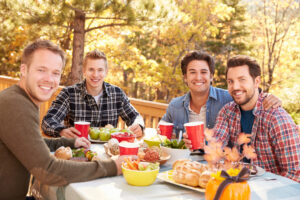
It would be nice if, as much as can, we can each choose, commit, and sustain an attitude of healthy self-care, not only for fun esthetics like “looking good,” but also for “feeling good” subjectively and also “being good” in terms of at least trying to sustain optimal health, at least as evidenced by blood chemistry tests, blood pressure, heart rate, and other objective measurements of how well our bodies are working. How they “look” on top of that is an added bonus.
With all of life’s stressful changes and stressors, this can be a challenge, but that’s part of the fun. (As a late middle-age/early senior gay man myself, I love the challenge of being in the gym often, and enjoying the certain naughty/smug “bragging rights” of wearing the same pants size I wore in college; call it a guilty pleasure; not to be obnoxious, but to luxuriate in the joys that feeling healthy can bring).
Special Diets and Values in Cultures
In addition to the phase-of-life issues related to gay men, and to the cultural issues (pressures, or advantages) that we face, some gay men have special circumstances, such as following a kind of diet or “lifestyle” (although I generally hate that word, because of how bigot homophobes reduce us to remarks about the “homosexual lifestyle” that they “don’t agree with”; I just say, “fuck you” to that, because I’m older and give fewer fucks (see above)).
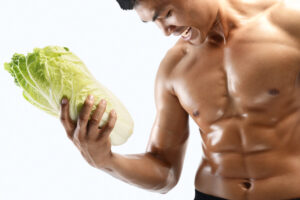
The eating “lifestyles” many, including gay men, might follow include being Orthodox Jewish and keeping “kosher,” which has its own set of rules about food sources and preparation, or being vegetarian or vegan for nutritional, ethical, health, or other reasons. Older men often are encouraged by their physicians to adopt a “Mediterranean” or “heart-healthy” diet to reduce heart attack and/or stroke risk, which is a major consideration. Bodybuilders certainly have a food lifestyle that can be arduous, such as “meal prep” and “hitting their macros” of protein, fat, and carbs, in addition to “bulking” (calorie surplus) versus “cutting” (calorie deficit), in very precise measurements and food selections to achieve the sport of physique esthetics, which can pose additional challenges about indulgence/deprivation/sacrifice/commitment.
The Existential Challenge of Quantity versus Quality of Life
There are certainly many people, including gay men, who get fed up with the challenges of making food choices and diet discipline and generally ignore them. This can have a certain “liberation” to it, but it can also make them vulnerable to not looking, feeling, or “being” “good” on a health markers level. And for some, that’s OK, because existentially, they see life as to be enjoyed, and part of that definition of enjoyment for them is to just “do whatever.” This can (and does) result in sometimes a shorter or less-healthy life, but that can also be a very empowered choice, and self-empowerment is a powerful life value (my book from 2013 is Self-Empowerment: Have the Life You Want!, available here). We are often confronted with the dilemma in life of choices that affect the quality versus the quantity of life, and our lives are comprised of things we can influence (through choices in our thinking and behavior), and things we can’t, such as inherited traits or life circumstances.
Our very individualized (despite gay men’s cultural pressures) relationships to food and exercise are related to very important life variables such as our self-esteem, mental health, self-care, and self-empowerment, throughout the lifespan, and in every national, local, and family culture. The biggest question is, what’s right for you?
If you’d like support for closing the gap between how you’re approaching all this, versus how you’d like to be, consider therapy or coaching. I’d be happy to help you be at your best, whether it’s about how you-take-care-of-you in diet/exercise, or other life variables like your relationships, sex life, career, finances, social life, or family life. Email me at Ken@GayTherapyLA.com, or call/text 310-339-5778, for more information.

Ken Howard, LCSW, CST, is a Licensed Clinical Social Worker (#LCS18290) in California, an AASECT Certified Sex Therapist, and a former academic (Adjunct Associate Professor) at the University of Southern California (USC) Suzanne Dworak-Peck School of Social Work, and the Founder of GayTherapyLA. He is the most experienced gay men’s specialist psychotherapist and life/career/relationship coach for 30 years in 2022, and is in full-time private practice in West Hollywood, California, where he lives with his husband of 20 years. A library of hundreds of blog articles are available on GayTherapyLA.com/blog, and his podcast is heard by over 5,000 people per month in over 40 countries of the world.

